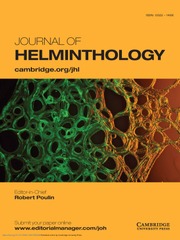No CrossRef data available.
Article contents
Morphological variety and mechanisms of formation of acanthocephalan cysts in intermediate host
Published online by Cambridge University Press: 31 March 2025
Abstract
This report provides an overview of available data on the ultrathin structure and the mechanisms of formation of cysts around acanthocephalans of the classes Palaeacanthocephala and Archiacanthocephala in intermediate hosts. In most of the described cases, the cyst is bi-layered, consisting of an outer layer that is relatively thick and vesicular, and an underlying layer that is thin and amorphous. In acanthellae of some species, a lamellar layer is observed on the cyst surface, which degrades presumably at the cystacanth stage. Three probable mechanisms of cyst formation in acanthellae of different species have been identified. The first and second mechanisms involve the border of microvilli that develops on the tegument surface. In acanthellae of the first group, the cyst’s vesicular layer is formed by detachment of fragments or small vesicles from microvilli, a process resembling the micro-apocrine secretion, while the amorphous layer is composed of electron-dense material released from invaginates of the tegument’s outer membrane and the remaining microvilli. In acanthellae of the second group, the cyst is single-layered and formed presumably of whole microvilli separated from the tegument. Since acanthellae of the third group lack microvilli on the tegument surface, the vesicular layer of the cyst is formed of a few small vesicles and amorphous material synthesized deep in the tegument and in large vesicles transported to the parasite’s surface. The amorphous, electron-dense layer of the cyst is formed in the same manner as in the first group, but without microvilli.
- Type
- Review Article
- Information
- Copyright
- © The Author(s), 2025. Published by Cambridge University Press


